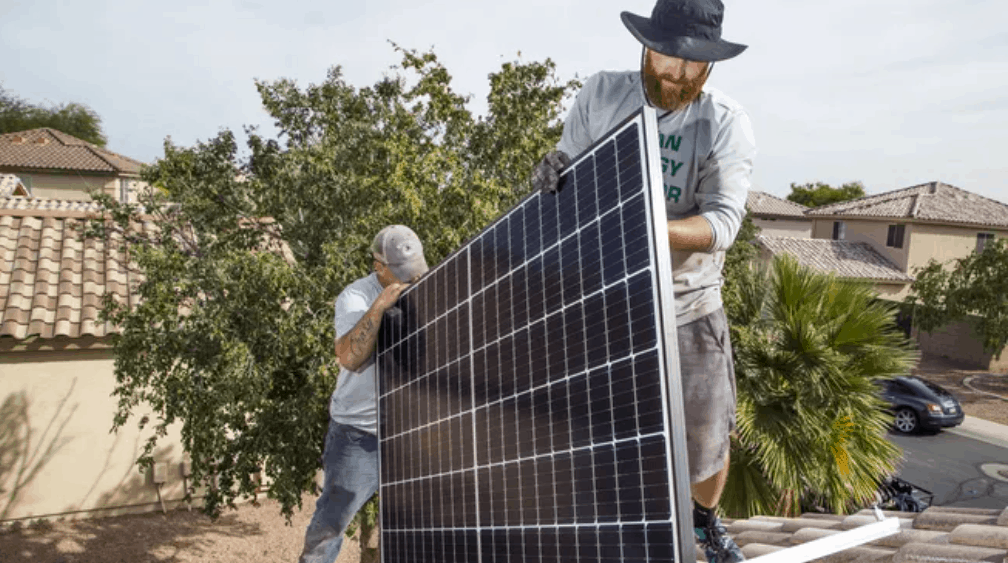
Arizona utility regulators on Thursday, in a split vote, approved a plan for utilities to get all of their energy from carbon-free sources like solar and nuclear energy by 2050, bringing the state closer in line to other Western states.
The new regulations require electric utilities to get half their power from renewable energy like solar and wind in 2035. Then in 2050, they would need to supply all customer demand for electricity with either renewables, carbon-free nuclear, or energy-efficiency measures such as subsidizing low-watt lightbulbs or attic insulation for customers.
The new requirements will spur development of solar plants, battery storage and other renewables, though commissioners debated whether the rules will affect customers’ bills. Because the rules require additional energy-efficiency measures, they are likely to include opportunities for customers to save through utility conservation programs.
Arizona Corporation Commissioners approved the measure, which increases the requirements for the first time in 14 years, on a 3-2 vote. Voting in favor of the new rules were Republican Chairman Robert Burns, Democrat Sandra Kennedy, and Republican Boyd Dunn. Opposed were Republicans Justin Olson and Lea Márquez Peterson.
Electric utilities would have to phase out coal- and natural-gas-burning power plants, and would need to start soon, because the plan has interim requirements that utilities cut carbon emissions in half by 2032 and 75% by 2040.
The carbon reductions would be based on how much carbon a utility’s power plants emitted on average in the years 2016-18.
The new rules update the Renewable Energy Standard and Tariff that an all-Republican commission passed in 2006 and requires utilities to get 15% of their power from renewables by 2025, as well as the 2010 energy-efficiency requirements for them to use efficiency measures to meet 22% of their energy demand by this year.
Customers at Arizona’s biggest utility pay about $3.50 a month now to fund the utility’s compliance with those rules.
‘We’ve done something … important for the future of the state’
“The climate crisis is impacting Arizonans right now. I am glad the commission was finally able to look past partisan politics to support science and economics-based policy that stakeholders, utilities and ratepayers could all agree upon and benefit from,” Kennedy said in a prepared statement after the vote.
Dunn concurred. “We’ve done something that’s certainly important for the future of the state,” he said as the meeting wrapped up.
Also approved Thursday was an update to the requirements for how utilities plan and build new power plants or make deals to buy power from others, with commissioners giving the OK to proposals that advocates such as the clean-energy advocacy Western Grid Group and Sierra Club said will make utility resource plans more transparent and competitive.
The commissioners approved the changes as amendments to a massive rule set they have considered since July, and that has been under review for four years.
While they had the votes to pass the new requirements, they will need to reconvene at some point and vote on the entire rule set, as they didn’t get to that Thursday.
They made so many changes to proposed rules that they requested the commission staff take time to put the changes on paper so they could be reviewed before a final vote.
“We’re afraid we’re going to lose something through the cracks here with all the changes we’ve made and so forth,” Burns said.
Arizona’s requirements were keeping up with the times when they passed, but California, Colorado, Montana, Nevada, New Mexico, Oregon and Washington all have more ambitious renewable or carbon-free energy targets today, passed by their lawmakers or by voters.
The new requirements would make Arizona’s renewable rules stricter than Montana, Oregon and Washington, although Washington’s goal of going carbon-free is to do so by 2045, five years earlier than Arizona.
Earlier in October the commissioners approved an increase in the state’s energy-efficiency requirements for utilities. Under that new rule, utilities must implement enough energy-efficiency measures by 2030 to equal 35% of their 2020 peak demand. The new rule also includes interim requirements to ensure utilities are working toward that annually.
But the commissioners couldn’t sort out the details of many other ideas in the energy rules at that Oct. 14 meeting, so they recessed until Thursday, where they approved more changes to the requirements.
Márquez Peterson opposed the requirement for renewable energy, wanting instead to focus only on carbon emissions and not direct utilities to use renewables to achieve that goal.
Commissioners spar over comparison to 2018’s failed Proposition 127
Olson, meanwhile, opposed any new mandate.
“I honestly am quite frustrated that we sit here today as a commission adopting standards that are very similar to the standards that were rejected soundly by the voters two years ago in Prop. 127,” he said, invoking the renewable-energy ballot measure supported by billionaire Tom Steyer that failed in Arizona.
Olson proposed a rule that utilities not be allowed to spend more than $1 million annually to meet the new requirements, which Márquez Peterson supported but failed with the other three commissioners opposed.
Dunn defended the rules, saying they were nothing like the ballot measure that he said would have constrained utilities in how they plan for future electricity demand.
Burns also defended the rules, saying companies looking to expand or move to Arizona increasingly want to know the state has renewable energy requirements.
When the commission took up the issue in July, On Semiconductor in Phoenix, the Arizona Technology Council (which has 750 members in the state), aluminum manufacturer Ball Corp. and nine other large companies issued a joint endorsement of increased renewable requirements.
They cited research from sustainability nonprofit Ceres that indicates Arizona utility customers saved $2 billion from 2008 to 2018 because of the existing renewable-energy rules, which spurred many solar and wind projects in the state.
New requirements for power storage
Included in the new rules is a requirement that by 2036, utilities have enough energy storage, likely in the form of large batteries, to equal 5% of the utility’s 2020 peak demand, and a portion of that needs to be owned by customers, not the utility.
The requirement is similar to a rule in the original renewable requirements that a portion of the renewable energy supply for utilities comes from “distributed” resources rather than centralized power plants. Nearly all “distributed” generation is rooftop solar on homes and businesses.
“Battery storage can open up so many additional uses for rooftop solar,” said Bret Fanshaw, Solar United Neighbors Arizona program director, in a statement after the vote.
“Households will be able to save money and reduce costs on the electricity system by storing solar power during the day and using it when the sun goes down. With this standard, we are excited for all of the benefits of solar-plus-storage to take hold in Arizona.”
The requirement is estimated to bring 200 megawatts of battery capacity to customers in Arizona Public Service Co. and Tucson Electric Power Co. territories by 2035, according to solar and battery trade groups and companies that pushed for the rule.
The new rules, if they are passed on a subsequent vote, will prompt utilities to offer incentives and fees to help customers buy batteries for their property and get credit for any stored energy utilities use.
The rules also will require a hearing process before an administrative-law judge to ensure they are appropriate before they take effect. That likely will take a few months.
























